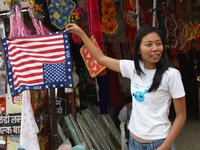Friday, October 02, 2009
Thursday, November 09, 2006
Jack, the coolest Tibetan in the world.

This is Jack. His real name is Tenzin, but he let us call him Jack because every other Tibetan person we met along the way had the same first name as him. Like many Tibetans of his generation, he was born in India, a child of the first set of refugees to arrive with the Dalai Lama back in 1959.
Jack is our hero because he took us all the way from Delhi to Dharamsala--about 17 total hours on crazy, dusty, often unpaved roads--and managed to keep us entertained the whole entire way. He showed us everything from the Dalai Lama's birthday celebration to Lil' Bow Wow music videos on his little Daewoo DVD player. He told us stories. Sometimes he just shut up and listened to us yap. But when he did give us advice, it was always almost too wise for his years (he's 31). By the time we arrived at the cultural epicenter of the Tibetan community in Dharamsala, we already had a good sense of the prevailing attitude of his people that allowed them to maintain peaceful acceptance even while in exile.
Once we got to Dharamsala, Jack knew everybody from the grandma selling jewelry on the corner to the rock band performing at the Students for a Free Tibet concert to the government-employed security guard who refused to let Cherlyn into the main temple because she was carrying all our cameras for us. After he convinced the big scary guy to let her through because she was his homegirl, we met his entire family at the main temple--his lovely wife, baby girl, his brother who works for the Department of Homes, his uncle who was visiting from Seattle. We talked and talked until the Dalai Lama showed up--he was being escorted to his car--and that's when the crowd went silent, and everyone's eyes welled up with tears of respect as the simple yet amazing monk smiled his way onto his SUV.
Friday, November 03, 2006
The cast and crew.

I got off the airplane around 7:30pm in Delhi. It was dark, dusty, and chaotic. These are the people I traveled with:
 Tom: A law professor from San Francisco, whose mission is to get rich people "out of their Mercedes" and into the impoverished streets to see how reality treats the less fortunate.
Tom: A law professor from San Francisco, whose mission is to get rich people "out of their Mercedes" and into the impoverished streets to see how reality treats the less fortunate. Angela: A Cambodian business owner and non-profit organizer from San Jose who had all kinds of fun things--like Seltzer water from the airplane--tucked inside her backpack.
Angela: A Cambodian business owner and non-profit organizer from San Jose who had all kinds of fun things--like Seltzer water from the airplane--tucked inside her backpack. Harjit: Our embedded Indian, who helped us translate and negotiate prices on jewelry with the sweetest Hindi you've ever heard.
Harjit: Our embedded Indian, who helped us translate and negotiate prices on jewelry with the sweetest Hindi you've ever heard.
Rebecca: Assemblywoman extraordinaire, whose talents range from passing laws on domestic violence to passing out Skittles to delighted little Sikh kids.

Hekani: Out "guide," a beautiful lawyer who will someday be the face of the campaign to free Nagaland.
 Cherlyn: The youngest of the crew who, at 22, looks like a princess by day and meows like a cat in her sleep by night.
Cherlyn: The youngest of the crew who, at 22, looks like a princess by day and meows like a cat in her sleep by night. And me.
And me.
Thursday, November 02, 2006
Survivors of the trek to Dharamsala.
 I just came back from two weeks in India, where I interviewed survivors of the recent shooting at the China-Nepal border. It was the morning after they'd arrived to their safe haven:
I just came back from two weeks in India, where I interviewed survivors of the recent shooting at the China-Nepal border. It was the morning after they'd arrived to their safe haven:On Tuesday, October 24th, 41 refugees arrived in Dharamsala, India. They were all young, between the ages of 7 and 28. Contrary to what you might think, the new arrivals seemed more happy and relieved than distressed and traumatized. Maybe they realized how lucky they are to have survived the fatal shooting on the Nangpa La Pass three weeks earlier. That's the riskiest part of the pilgrimage to Dharamsala, the epicenter of Tibetan government and culture and home to His Holiness the Dalai Lama. When they started off, there were 75. By the time the Chinese were through with them, a nun had been shot dead, and 33 others were detained and imprisoned.
 A refugee's journey is never easy, but at least the Tibetans have several safe points along the way, and the promise of physical and spiritual freedom when and if they make it to Dharamsala. Here's how the Director of the Tibetan Refugee Center, Dorjee, explained it to me:
A refugee's journey is never easy, but at least the Tibetans have several safe points along the way, and the promise of physical and spiritual freedom when and if they make it to Dharamsala. Here's how the Director of the Tibetan Refugee Center, Dorjee, explained it to me:"Once they get to Nepal, the UNHCR has a center set up where the refugees can get exit passes from Nepal and special entry permits into India. They're given some food, a bus, and a travel agent, and are sent on their way to New Delhi. The UNHCR also sends us some money to pay for the reception costs. Once they get to India, they're registered with our center's Delhi branch. Then we at the headquarters get a call that newcomers have arrived. Finally, they are brought to Dharamsala by bus along with other refugees."
 Dorjee welcomes about 3000 refugees a year at his center. Most of them are children whose parents urged them to leave Tibet because Tibet is turning into hell on earth. Any mention of the Dalai Lama could get you jailed and tortured; the slightest mistake could lead to your disappearance minutes later. Risking frostbite and death by gunpoint is a small price to pay when one of the most powerful countries in the world is out to destroy any remnants of your cultural existence. This refugee center opened in 1990. 85 refugees arrived yesterday, including the 41 that escaped the shooting. Some sick, some old, some injured. But all happy to be here, and looking forward to the audience with the Dalai Lama.
Dorjee welcomes about 3000 refugees a year at his center. Most of them are children whose parents urged them to leave Tibet because Tibet is turning into hell on earth. Any mention of the Dalai Lama could get you jailed and tortured; the slightest mistake could lead to your disappearance minutes later. Risking frostbite and death by gunpoint is a small price to pay when one of the most powerful countries in the world is out to destroy any remnants of your cultural existence. This refugee center opened in 1990. 85 refugees arrived yesterday, including the 41 that escaped the shooting. Some sick, some old, some injured. But all happy to be here, and looking forward to the audience with the Dalai Lama. These two boys were among the 41 who survived the shooting. Dorjee's secretary warned me not to reveal their full faces or names, because if the Chinese saw it they might hurt their families. 13-year old Tenzin (left) made the 22-day journey with his 2nd cousin, Tsering (right). He's smiling a lot, because he's meeting the Dalai Lama today. He showed me his white scarf, which the Dalai Lama will put around his neck as a blessing. Tenzin left his parents and two brothers behind in Tibet. "They wanted me to have a better education in India," he said. When I asked him if he thinks he'll ever see his family again, he just laughed, as if that was the stupidest question in the world. Tomorrow, Tenzin will move out of the refugee center to the Tibetan Children's Village, a 2,500-kid strong orphanage and school set up by the Dalai Lama's sister.
These two boys were among the 41 who survived the shooting. Dorjee's secretary warned me not to reveal their full faces or names, because if the Chinese saw it they might hurt their families. 13-year old Tenzin (left) made the 22-day journey with his 2nd cousin, Tsering (right). He's smiling a lot, because he's meeting the Dalai Lama today. He showed me his white scarf, which the Dalai Lama will put around his neck as a blessing. Tenzin left his parents and two brothers behind in Tibet. "They wanted me to have a better education in India," he said. When I asked him if he thinks he'll ever see his family again, he just laughed, as if that was the stupidest question in the world. Tomorrow, Tenzin will move out of the refugee center to the Tibetan Children's Village, a 2,500-kid strong orphanage and school set up by the Dalai Lama's sister.Tsering, who is 18, knew he wouldn't get decent work if he stayed in Tibet. But here in Dharamsala, he'll receive skills training and English and Hindi classes at the Transit School for newly arrived Tibetan refugees 18 and older. "We walked through snow that was up to our knees," he said. "Our eyes and faces were burning. When the Chinese started shooting, we dropped all our bags and hid in the Nangpa La Pass."
I'll probably never see this kids again, but I'm not worried about them. The Tibetans have an amazingly warm and functional reception system for refugees from all walks of life. More on that later.

